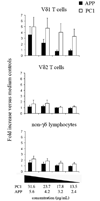Response of gammadelta T Cells to plant-derived tannins
- PMID: 19166386
- PMCID: PMC2751790
- DOI: 10.1615/critrevimmunol.v28.i5.20
Response of gammadelta T Cells to plant-derived tannins
Abstract
Many pharmaceutical drugs arc isolated from plants used in traditional medicines, and new plant-derived pharmaceutical drugs continue to be identified. Relevant to this review, different plant-derived agonists for gammadelta T cells are described that impart effector functions upon distinct subsets of these cells. Recently, plant tannins have been defined as one class of gammadelta T cell agonist and appear to preferentially activate the mucosal population. Mucosal gammadelta T cells function to modulate tissue immune responses and induce epithelium repair. Select tannins, isolated from apple peel, rapidly induce immune gene transcription in gammadelta T cells, leading to cytokinc production and increased responsiveness to secondary signals. Activity of these tannin preparations tracks to the procyanidin fraction, with the procyanidin trimer (C1) having the most robust activity defined to date. The response to the procyanidins is evolutionarily conserved in that responses are seen with human, bovine, and murine gammadelta T cells, although human cells show less selectivity. Procyanidin-induced responses described in this review likely account for the expansion of mucosal gammadelta T cells seen in mice and rats fed soluble extracts of tannins. Use of procyanidins to activate gammadelta T cells may represent a novel approach for the treatment of tissue damage and autoimmune diseases.
Figures





References
-
- Summer J. The Natural History of Medicinal Plants. Timber Press; 2000. pp. 15–18.
-
- Lietava J. Medicinal plants in a Middle Paleolithic grave Shanidar IV. J Ethnopharmacol. 1992;35(3):263–266. - PubMed
-
- Chen X, Beutler JA, McCloud TG, Loehfelm A, Yang L, Dong HF, Chertov OY, Salcedo R, Oppenheim JJ, Howard OM. Tannic acid is an inhibitor of CXCL12 (SDF-1alpha)/CXCR4 with antiangiogenic activity. Clin.Cancer Res. 2003;9(8):3115–3123. - PubMed
-
- Tokura T, Nakano N, Ito T, Matsuda H, Nagasako-Akazome Y, Kanda T, Ikeda M, Okumura K, Ogawa H, Nishiyama C. Inhibitory effect of polyphenol-enriched apple extracts on mast cell degranulation in vitro targeting the binding between IgE and FcepsilonRI. Biosci.Biotechnol.Biochem. 2005;69(10):1974–1977. - PubMed
-
- Graff JC, Jutila MA. Differential regulation of CD11b on gammadelta T cells and monocytes in response to unripe apple polyphenols. J Leukoc Biol. 2007;82(3):603–607. - PubMed
Publication types
MeSH terms
Substances
Grants and funding
LinkOut - more resources
Full Text Sources

